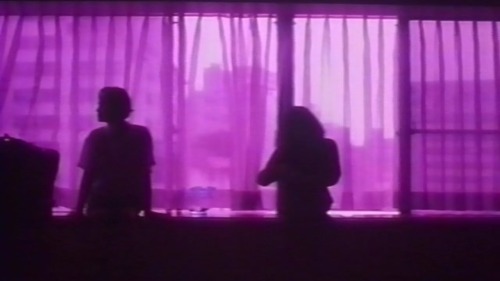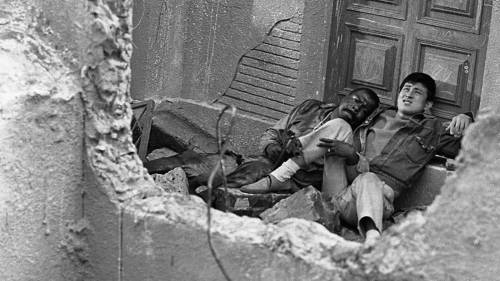#underground film

Thesoundtrack by DAS is available on Bandcamp now Name your price Throw my bud a few bucks for his amazing music

Edie Sedgwick in Poor Little Rich Girl (1965) - directed by Andy Warhol.
NEKO-MIMI (1993)
Directed by Jun Kurosawa
Doomsy’s Rating: 87/100
NEKO-MIMI is a film that acts as a slipstream to almost every emotion possible, floating through time and space from elation to enmity. It sets you adrift in a headspace of beauty and darkness, but Jun Kurosawa effortlessly blends the gorgeously grainy lo-fi cinematography with a full spectrum of hues, tints, and colors that extended to every area of the rainbow so that the mind can feel them. The experience stands as more or less a mood ring of a film, changing palette and filming techniques with the unstable emotions of the characters, who remain lost in permanent thought loops that only lead to their irrevocable self-destruction. In terms of experimental avant-garde Japanese cinema, this is right up there for best I’ve seen. A remarkable gem of haunting surrealism.
Post link
Blood Orgy of the Leather Girls (1988)
Directed by Meredith Lucas
Doomsy’s Rating: 93/100 (on my Great Films list!)
A radical, punk explosion of feminine rage.
I don’t even know how to describe this, other than it being absolutely essential viewing for riot grrrls and punk rock girls everywhere. This is certainly not an easy sell to a lot of people, as some of the production values are unquestionably shaky, but director Meredith Lucas and producer Jon Jost (yes, Jon Jost!) make up for it with some aggressive and hyperkinetic cinematography and stream-of-consciousness editing, not to mention a BANGING score. Lucas is demonstrably a fan of the Russ Meyer school of empowerment, but with a firmly lesbian-gaze toward her protagonists. Everything about this film is caricatured to the point of becoming basically a cartoon. There’s loads of over-the-top comic-strip splattery violence (usually with the abhorrent men on the receiving end) and tons of scenes of the girls walking around carrying immense shotguns and wearing punk leather jackets and the whole movie just feels like the biggest riot grrrl recruitment ad I’ve ever seen (in the best way possible).
It’s interesting to note how the story is told from a male perspective (a clearly-defined attack on that gender’s perceptions of women as a threat to their own insecurities), as all the men depicted are either buffoons, selfish pigs, or almost playing a comic-book level of misogyny in a villain-screaming-about-world-domination way. There’s sequences where the male narrator literally describes women as “another, more dangerous species” and it is through this satire that we understand not only the brilliantly self-deprecating style of Lucas (not unlike Jon Moritsugu’s attack on L.A. culture’s historically despicable treatment of Asian-Americans) where violence begets violence, but here in the fantasy world of The Leather Girls it is the women who hold all the power, and all the best weapons. This is fantastic lo-fi filmmaking, and simply a cult classic waiting for to be found. If you love punk cinema, feminism, Lizzie Borden, or any of the 80s underground, this is gonna hit all the notes you want.
Please, everyone reading this give it a watch. It’s so worth a viewing.
Post link
Black Sun (1964)
Directed by Koreyoshi Kurahara
Doomsy’s Rating: 81/100
One of the areas of history that is so underrepresented on screen was the relationship between the Japanese and the American GIs still stationed in Japan after the conclusion of WWII. Black Sun, The first film I’ve viewed by underground filmmaker Koreyoshi Kurahara, has a STARTLINGLY progressive agenda of tolerance given its time of release and the country it originates from. The story concerns Akira, a young squatter and anarchist who can’t stop getting into trouble with the law and a black GI named Gill, who wields a very large gun and is on the run from both his racist American commanding officers and the Japanese police. These two men team up to protect each other from their pursuers and develop something of an understanding despite the fact they cannot communicate. The film then becomes a wacky blend of off-color humor, revolutionary political posturing and ultimately tragedy.
There is so much to admire here. One is the highly unorthodox, borderline guerilla cinematography, so emblematic of the punk-oriented style of independent filmmaking present in the Japanese New Wave. Much like Toshio Matsumoto’s Funeral Parade of Roses,Black Sun has aged so well because it’s not merely a “message” film, but a fascinating story of a friendship that transcends language and race. Gill is also no caricature. He is a complex man and his background is largely left to the imagination, but it is very clear that he is all alone. Not just linguistically, but also because the empathy of others in this world seems totally foreign. The fact that a film makes this much effort to give a POC so much character development (and four years before Night of the Living Dead) alone makes this essential viewing for its oddity status, but the fantastic jazz score is highly worthy of praise.
Watched on Criterion Channel.
Post link
Throw Away Your Books, Rally in the Streets (1971)
Directed by Shuji Terayama
Doomsy’s Rating: 98/100 (on my Great Films list!)
An undying punk manifesto: The faces spit on, burned onto celluloid forever. Terayama’s magnum opus, a scathing and incendiary battle cry for the disenfranchised and downtrodden. Never lost, never forgotten, these are the words spoken by those too obscure to hear. But here, and if only here, can they be heard with every desperate plea for change. The anger in this film could burn down the world, so full of resentment towards adults, towards authority, and towards oppression it will likely never be matched. The incomparable visual aesthetic is guerrilla, gutsy, and unapologetic, so steadfastly eager to capture the justifiable rage of the loners, the losers, the punks, the LGBT community, all those society has shit upon for far too long. Makes an excellent trilogy of the Japanese underground with Toshio Matsumoto’s Funeral Parade of Roses and Yoshihiko Matsui’s Noisy Requiem. Essential viewing for outsiders everywhere.
Post link





